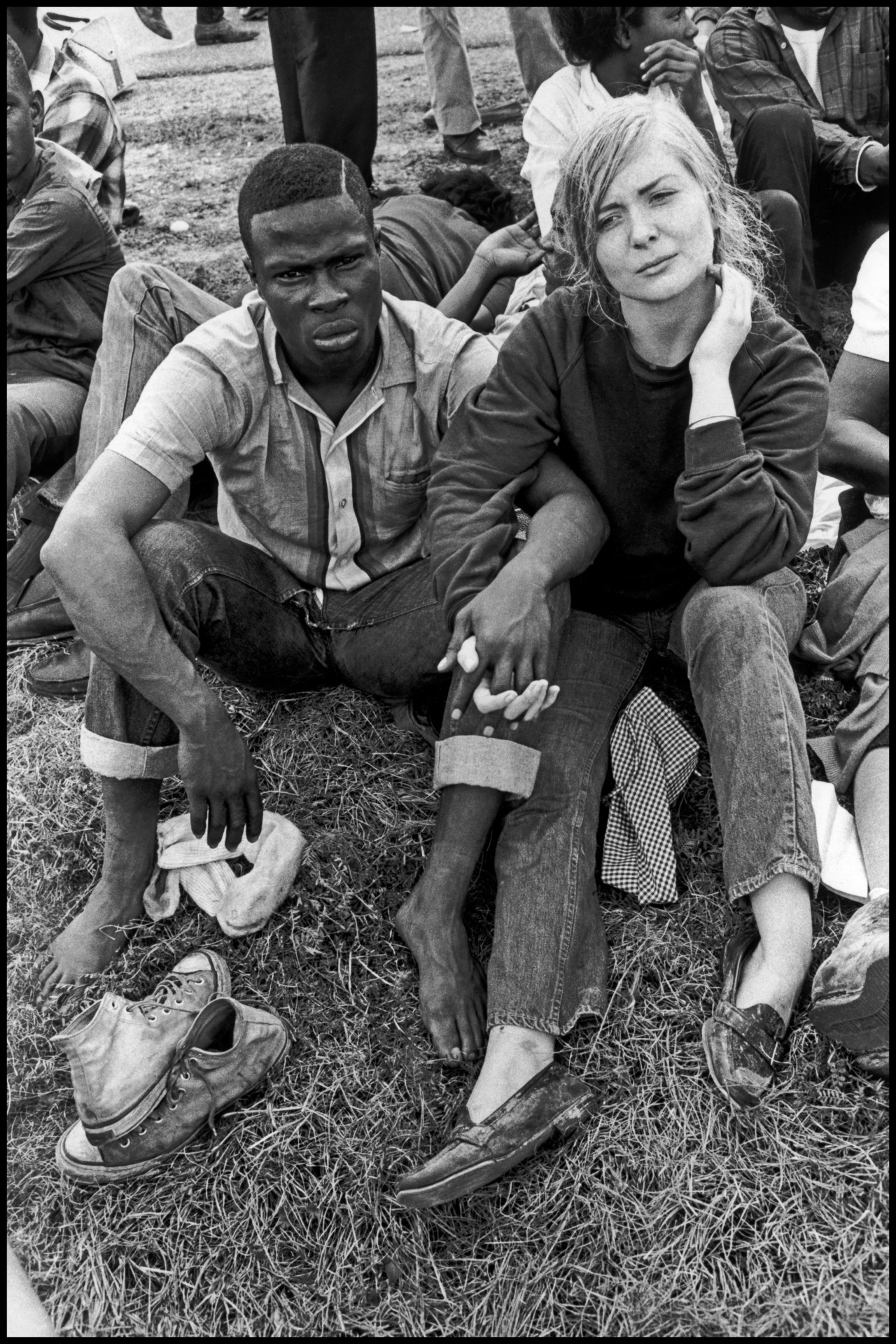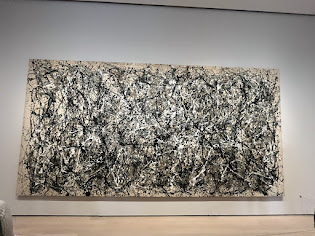HCCC celebrated Dr. King’s activism through historical documents, the arts, and community projects in the Benjamin J. Dineen III and Dennis C. Hull Gallery. The exhibit timeline began with King’s legendary visit to Jersey City and archives other social changes throughout the decades, ended with the Black Lives Matter Movement. In the spirit of MLK’s National Day of Service, HCCC partnered with Goya Foods and are accepting can donations to support the HCCC food pantry and Hudson Helps.
Eli Reed , Anti-racism March. Forsyth County, Georgia, USA. 1987.Photography. 6 x 6 in
"This photo was taken in 1987. The artist states: "A small group of Afro-American protesters was racially attacked in Forsyth County, Georgia, in 1987. Captured by network television cameras covering the protest, the attack consisted of acts of physical, racist abuse perpetrated in a county known as an unsafe place for Afro-Americans after dark. Forsyth County was descended upon two weeks later by thousands of supporters from all over the country (estimated numbers ranged from 12,000 to 20,000), rallying in support of the original protesters who had been attacked while practicing their legal right to peaceful assembly". " https://www.artworkarchive.com/profile/hudson-county-community-college-foundation-art-collection/artwork/anti-racism-march-forsyth-county-georgia-usa-1987
Bruce Davidson, protest march from Selma to Montgomery, Alabama, 1965
"On March 22, 1965, 300 Civil Rights demonstrators began a march from Selma, Alabama to the state capitol of Montgomery to confront local institutions which obstructed African Americans from registering to vote. Three days later, their number had swelled to more than 25,000 as they gathered at the state capitol building to listen to a speech given by Martin Luther King, Jr. and deliver a petition to segregationist Governor George Wallace. This march was the third attempted in 1965. The first was made on March 7, when state and county police impeded and then attacked demonstrators at Selma’s Edmund Pettus Bridge. Two days later Martin Luther King, Jr. led a ceremonial march across the bridge for a brief prayer session before being given a court order that ended the event. These three marches, including the bloody repression at the Pettus Bridge, were greatly publicized and drew national attention to voter rights in the South. Appalled at what he’d seen, on March 15, President Lyndon B. Johnson presented a bill to Congress which would become the Voter Rights Act, one of the most effective pieces of Civil Rights legislation ever implemented. In 1960 there were 53,000 registered black voters in Alabama but 10 times that amount in 1990." https://www.magnumphotos.com/newsroom/society/bruce-davidson-selma-marches/


Malcolm X
"Malcolm X (born Malcolm Little, later el-Hajj Malik el-Shabazz; May 19, 1925 – February 21, 1965) was an American Muslim minister and human rights activist who was a prominent figure during the civil rights movement. A spokesman for the Nation of Islam until 1964, he was a vocal advocate for Black empowerment and the promotion of Islam within the Black community. A posthumous autobiography, on which he collaborated with Alex Haley, was published in 1965.
Malcolm spent his adolescence living in a series of foster homes or with relatives after his father's death and his mother's hospitalization. He committed various crimes, being sentenced to 10 years in prison in 1946 for larceny and burglary. In prison he joined the Nation of Islam (adopting the name Malcolm X to symbolize his unknown African ancestral surname while discarding "the White slavemaster name of 'Little'"), and after his parole in 1952 quickly became one of the organization's most influential leaders. He was the public face of the organization for 12 years, advocating Black empowerment and separation of Black and White Americans, and criticizing Martin Luther King Jr. and the mainstream civil rights movement for its emphasis on nonviolence and racial integration.[2][3] Malcolm X also expressed pride in some of the Nation's social welfare achievements, such as its free drug rehabilitation program.
A controversial figure accused of preaching racism and violence, Malcolm X is also a widely celebrated figure within African-American and Muslim American communities for his pursuit of racial justice. He was posthumously honored with Malcolm X Day, on which he is commemorated in various cities across the United States. Hundreds of streets and schools in the U.S. have been renamed in his honor, while the Audubon Ballroom, the site of his assassination, was partly redeveloped in 2005 to accommodate the Malcolm X and Dr. Betty Shabazz Memorial and Educational Center."
https://en.wikipedia.org/wiki/Malcolm_X
The Trumpet of Conscience
"The Trumpet of Conscience features five lectures that Martin Luther King, Jr., delivered in November and December 1967 for the Canadian Broadcasting Corporation (CBC) Massey Lectures. Founded in 1961 to honor Vincent Massey, former Governor General of Canada, the annual Massey Lectures served as a venue for earlier speakers such as John Kenneth Galbraith and Paul Goodman. The event, sponsored by the University of Toronto’s Massey College, is broadcast each year on the CBC Radio One show “Ideas.” Prior to King’s assassination, the book was released under the title Conscience for Change, through the CBC. After King’s death in 1968, the book was republished as The Trumpet of Conscience, and included a foreword written by Coretta Scott King. The book reveals some of King’s most introspective reflections and his last impressions of the movement.
Each of the five orations encompasses a distinct theme pertinent to the African American civil rights struggle. In his first talk, “Impasse in Race Relations,” King notes that although “the white backlash declared true equality could never be a reality in the United States,” he felt that “mass civil disobedience as a new stage of struggle can transmute the deep rage of the ghetto into a constructive and creative force” (King, Trumpet, 10; 15). The second lecture, “Conscience and the Vietnam War,” is a close parallel to the “Beyond Vietnam” speech that King gave at New York City’s Riverside Church in April 1967, in opposition to the war. “Youth and Social Action,” King’s third lecture, envisions the mobilized power of a united youth front in which “hippies,” “radicals,” and other youth activists work in tandem to combine their strengths (King, Trumpet, 49). In “Nonviolence and Social Change,” King defends nonviolent resistance as a political tool to convince “the wielders of power” to respond to national poverty (King, Trumpet, 62).
King’s concluding speech was a live broadcast of his 1967 Christmas Eve sermon at Ebenezer Baptist Church, “A Christmas Sermon on Peace.” The sermon illuminates King’s long-term vision of nonviolence as a path to world peace and contains many of King’s classical oratorical set pieces, including his description of agape. In his concluding comments, King refers to his remarks at the March on Washington for Jobs and Freedom and admits, “Not long after talking about that dream I started seeing it turn into a nightmare” (King, Trumpet, 76). He reviews the recent setbacks the movement faced, including violence during the Birmingham Campaign, persistent poverty, urban race riots, and an escalation of the war in Vietnam, and notes, “I am personally the victim of deferred dreams, of blasted hopes” (King, Trumpet, 76). In spite of these hurdles, King reassures his congregation: “I still have a dream. I have a dream that one day men will rise up and come to see that they are made to live together as brothers” (King, Trumpet, 76–77)." https://kinginstitute.stanford.edu/encyclopedia/trumpet-conscience

The Revolution Will Not Be Televised
"The Revolution Will Not Be Televised" is a poem and song by Gil Scott-Heron. Scott-Heron first recorded it for his 1970 album Small Talk at 125th and Lenox1, on which he recited the lyrics, accompanied by congas and bongo drums. A re-recorded version, with a full band, was the B-side to Scott-Heron's first single, "Home Is Where the Hatred Is", from his album Pieces of a Man (1971). It was also included on his compilation album, The Revolution Will Not Be Televised (1974). All these releases were issued on the Flying Dutchman Productions record label.
The song's title was originally a popular slogan among the 1960s Black Power movements in the United States. Its lyrics either mention or allude to several television series, advertising slogans and icons of entertainment and news coverage that serve as examples of what "the revolution will not" be or do. The song is a response to the spoken-word piece "When the Revolution Comes" by The Last Poets, from their eponymous debut, which opens with the line "When the revolution comes some of us will probably catch it on TV".It was inducted to the National Recording Registry in 2005.In 2021, it was ranked at No. 258 on Rolling Stone's "Top 500 Best Songs of All Time". " https://en.wikipedia.org/wiki/The_Revolution_Will_Not_Be_Televised
What i have shown is a small part of the works displayed in the exhibition. I liked the exhibition very much, and I liked the connection of the works with each other as ideas and issues put light on black people and their freedom, and at the same time their difference and diversity in all fields such as politics, demonstration, photography, journalism and art such as singing, writing, drawing, and influential leaders in the waves of change to black people such as Martin Luther King, Malcolm X, the roll of the society and the people for change , and religions Christian and Islam . The exhibition included many differences and artistic diversity in all its forms in an impressive and wonderful manner. I enjoyed every piece of art in the exhibition, but what i displayed was one of the things that most caught my attention. The exhibition is of great importance in identification the history of black people and their life's waves of change, learning from them, and being affected by it, in order to appreciate history and the people who influenced it, and what they have achieved now in terms of achievements and progress, and getting rid of discrimination and racism against race or religion and making peace.
Bruce Davidson The Selma March. Alabama, USA. 1965. © Bruce Davidson | Magnum Photos
Bruce Davidson Young girl during the Selma March from Selma to Montgomery. Alabama, USA. 1965. © Bruce Davidson | Magnum Photos
Bruce Davidson The Selma March. Montgomery, Alabama, USA. 1965. © Bruce Davidson | Magnum Photos
Bruce Davidson The Selma March. Along with the hostile bystanders, they found a few supporters of their cause. Montgomery, Alabama, USA. 1965. © Bruce Davidson | Magnum Photos
. Alabama, USA. 1965. © Bruce Davidson | Magnum Photos















Comments
Post a Comment